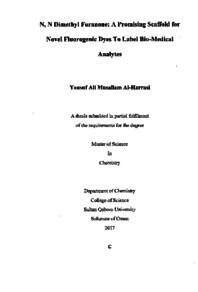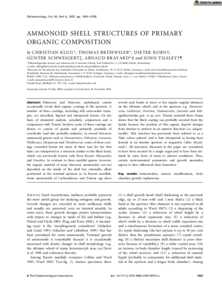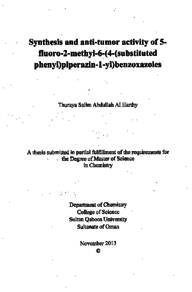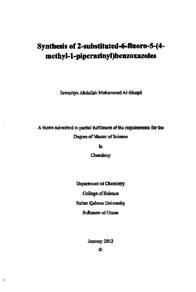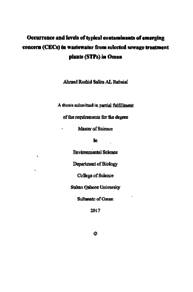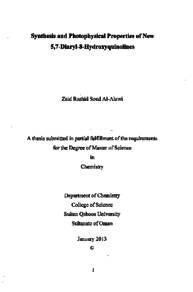Document
N.N. dimethyl furanone: apromising scaffold for novel fluorogenic dyes to label bio-medical analytes
Publisher
Sultan Qaboos University
Gregorian
2017
Language
English
English abstract
Due to rapid expansion of derivatization based separation techniques for the trace determination of biomedical analytes, the use of combination of separation techniques and pre and post-column derivatization procedures following by UV or fluorescence detection remains the most convenient and wide spread analytical approach. 3(2H)-Furanones are a type of biologically important five-membered heterocyclic compounds and has not yet been exploited for any analytical application. By taking advantage of this fact, a novel fluorescent dye (3-[5-(4 Dimethylamino-phenyl)-3-oxo-3H-furan-2-ylidenemethyl)-benzoic acid, DMAFB) based on 3(2H)-furanone skeleton was designed and synthesized. Despite recent developments, the determination of many drugs and naturally occurring compounds through their hydroxyl group and amino group remains challenging. In this compound we are considering carboxylic acid moiety as a trigger, which has the potential to be tagged with biomolecules through functional group conversion. Furthermore, photophysical properties of DMAFB were studied and interesting solvatochromic behaviour was observed. Due to the presence of proton acceptor, DMAFB displays pH-sensitive emission characteristics. The interaction of DMAFB with various micelles has been studied by steady state fluorescence. Moreover, the results obtained from the quantum chemical calculations supported the experimentally observed properties of the title compound. All the preliminary results that were obtained from this study prove that 3-furanone could be an interesting template for the design of novel organic fluorescent dyes, which are potentially applicable for bio-analytical purposes.
Member of
Resource URL
Arabic abstract
بسبب التوسع السريع لتقنيات الفصل القائمة على الإشتقاق لتحديد آثار المركبات الطبية في التحاليل الطبية الحيوية، فإن إستخدام مزيج من تقنيات الفصل وإجراءات ما قبل وبعد الإشتقاق و الكشف بإستخدام أجهزة الأشعة فوق البنفسجية أو أجهزة الومضان الضوئي يبقى النهج التحليلي الأكثر ملاءمة وسعة في الانتشار الفيورانات هي نوع من المركبات البيولوجية المهمة الغير متجانسة المتكونة من خمسة ذرات کربونية التي لم تستغل بعد في أي تطبيق تحليلي. من خلال الاستفادة من هذه الحقيقة، تم تصميم وتوليف صبغة جديدة مشعة (3-[5-(4ديميثيل امينوفينيل)-3-أوكسو۔ فوران-2میلیونیمثيل حمض البنزويك) المعتمدة على أساس هيكل الفورانون. على الرغم من التطورات الأخيرة، وتحديد العديد من المخدرات والمركبات التي تتكون بشكل طبيعي و المحتوية على مجموعات الهيدروكسيل والأمينو لا يزال الكشف عنها يشكل تحديا كبيرا. في هذا المركب نعتبر مجموعة حمض الكربوكسيل الجزء الذي لديه القدرة على الإرتباط مع المركبات الحيوية من خلال بعض المجموعات الوظيفية. وعلاوة على ذلك، تمت دراسة خصائص الفيزياء الضوئية من المركب وقد لوحظ سلوك مثير للاهتمام في المذيبات المختلفة. وبسبب وجود مستقبل البروتون المرتبط في المركب فإن الخصائص الضوئية كانت حساسة للرقم الهيدروجيني. وقد درس تفاعل المركب مع منشطات سطحية مختلفة من أجل دراسة خصائص الفيزياء الضوئية في الحالة الثابتة. وعلاوة على ذلك، فإن النتائج التي تم الحصول عليها من الحسابات الكيميائية الكمية تدعم الخصائص التي لوحظت تجريبيا من المركب المذكور. جميع النتائج الأولية التي تم الحصول عليها من هذه الدراسة تثبت أن 3خورانون يمكن أن يكون نموذجا لتصميم الأصباغ الفلورية العضوية الجديدة التي يمكن أن تكون قابلة للتطبيق الأغراض التحليل الحيوي.
Category
Theses and Dissertations

